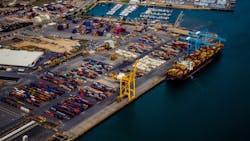Why is There a Shipping Container Shortage?
In addition to many other supply chain disruptions, logistics professionals face another challenge—a serious shipping container shortage. Many existing containers are tied up in ports, storage facilities and vessels worldwide. The shortage has been made worse by port congestion and rising demand.
This is why the supply chain faces a container shortage right now, when experts believe it may end and what professionals can do to navigate things in the meantime.
Where Have all the Containers Gone?
The container shortage began during the early days of the coronavirus. Shortly after the WHO declared COVID-19 to be a pandemic and manufacturers shuttered factories in response, many containers normally used to ship manufactured goods stopped moving. These containers were instead held at ports and inland storage facilities.
At the same time, ocean freight shippers reduced the number of vessels at sea in response to falling demand and the manufacturing slowdown. In addition to limiting global ocean shipping capacity, this decision also meant that empty containers stored at ports were no longer picked up. Empty containers in North America couldn’t be retrieved by cargo vessels for use elsewhere in the world.
Manufacturing and demand recovered more quickly in China than in North America and Europe. This uneven recovery resulted in an imbalance of containers, with Chinese ports facing a shortage and North American and European ports inundated with empty ones.
Port congestion and labor shortages mean that many of these containers are still stuck where they’re not needed—and current port data suggests this imbalance is still growing.
At the same time, global shipping didn’t stop, meaning the container imbalance is likely increasing as goods flow from China to Europe and North America, but empty containers do not flow back to China.
So long as recovery in the Chinese manufacturing sector continues to outpace recovery elsewhere, the imbalance will likely continue…or grow more severe.
The imbalance appears universal across all kinds of shipping containers, including refrigerated ones necessary for shipping certain cold chain goods.
How Long will the Container Shortage Last?
Some experts had predicted that the shortage could begin to wind down at some point in 2022, as an increase in container production would bring enough new ones into the global supply chain to ease imbalances.
However, it looks like container production is unlikely to provide the number needed to solve the current imbalance. There were some gains in 2021, but they were mostly marginal—less than 7% year over year, according to data from Drewry Maritime Research.
At the same time, complicating factors, such as the ongoing shipping industry labor shortage, continue to cause problems for shipping companies. In March 2022, container bookings remain hard to find, and prices are elevated well above pre-pandemic levels.
Market research firms don’t expect major growth in the container manufacturing industry over the next few years, meaning that extra supply probably won’t solve the shortage anytime soon.
Port Labor Issues and Low Sea Shipping Growth
The best hope for logistics professionals is that rising levels of sea shipping activity will speed the flow of containers worldwide, helping the global supply chain smooth out imbalances.
However, slow growth in sea shipping fleets may cause more problems. MSI’s latest estimate for containerized trade growth in 2021 was 6%, well above the fleet growth rate of 4.5%. If containerized trade continues to grow faster than cargo vessels fleets, sea shipping may not provide an end to the crisis.
Even as sea shipping grows, the movement of containers will likely be limited by other factors, like the current port labor crisis. Most ports in America face a serious shortage of workers, slowing the movement of goods and containers. Sickness among longshoremen hasn’t helped, though falling COVID-19 case rates suggest the virus may pose less of a threat to port workers shortly.
Most experts are unwilling to provide specific predictions on when the container shortage will end. Some say there’s likely no end in sight and that businesses should prepare for imbalances to continue slowing the global supply chain into the foreseeable future.
Steps Logistics Professionals and Businesses can Take
Because the shipping container shortage is likely to continue, businesses should begin adapting if they haven’t already.
Budgeting for increased shipping container costs can help businesses avoid being blindsided by the shortage’s consequences. Shipping news and market research can help companies make more informed decisions regarding their budgets.
Identifying and adopting alternatives to standard shipping containers could be an option for some businesses. Specialty versions like tricon, bicon and quadcon, which are smaller than traditional containers, may be easier to source than standard varieties. These are smaller and can provide efficiency advantages that may offset the higher costs.
Other strategies that can reduce the cost of logistics may also help. A closed-loop approach to manufacturing and logistics operations can cut down on waste and potentially reduce shipping costs. Supply chain management solutions that leverage data analytics may make it easier to track essential logistics KPIs and identify potential inefficiencies that increase shipping costs.
Certain best practices will also be helpful. Lead time will likely be much more important as containers remain in short supply. Planning orders 90 to 120 days in advance can help companies avoid delays as their logistics team attempts to secure a shipper with containers ready.
Working with distributors that operate worldwide may also help. These businesses may be able to take advantage of global opportunities that regional companies may not have access to. Similarly, distributors with stable shipping relationships may fare better than those that don’t prioritize long-term relationships with shipping partners.
No End in Sight for the Shipping Container Shortage
Experts predict that the shipping container shortage is likely to continue well into the future. Distributors, logistics professionals and most businesses will need to prepare for ongoing disruptions as shipping containers remain in short supply.
The right business practices—like increasing lead times on orders and budgeting for higher-than-usual container costs—can help companies navigate the shortage.
Emily Newton is an industrial and tech journalist and the editor-in-chief of Revolutionized.
About the Author

Emily Newton
Emily Newton has eight years of creating logistics and supply chain articles under her belt. She loves helping people stay informed about industry trends. Her work in Supply Chain Connect, Global Trade Magazine and Parcel, showcases her ability to identify newsworthy stories. When Emily isn't writing, she enjoys building lego sets with her husband.






